Basic techniques for placing flowers
It is important not only to purchase flowers and choose suitable pots, but also to arrange them correctly in the house, creating flower arrangements
In the bedroom
This is a place to sleep and rest, so the atmosphere here should be relaxing and conducive to healthy sleep. Therefore, poisonous plants with a strong smell are not suitable for the bedroom. It is better to place those options that purify the air and even emit a minimum of carbon dioxide at night. Such useful plants include spathiphyllum, chlorophytum, ficus, aloe. They will give positive emotions and contribute to relaxation of pelargonium, begonia, violet.
On the kitchen
As for the kitchen, there is usually high humidity and temperature changes. Therefore, flowers should be placed those that are able to withstand such conditions. In fact, you can place any flowers, the main thing is to take into account their location. Sanseieria, philodendron, common ivy, aspidistra, aloe, Kalanchoe, geranium, begonia will feel good in the kitchen.
You just need to remember that you should not place plants near the sink. Not only is it constantly wet and splashes are flying, it is also possible that drops of cleaning and detergents will get on the foliage. Flowers cannot be placed near the stove either. It's too hot there, and odors won't do the plants any good.
In the hall
The hallway is usually dark. Therefore, not every plant is able to survive here. It is desirable to create artificial lighting. The shadow of aglaonema, aspidistra, asplenium, sansevieria is well tolerated. Ferns feel great in a shaded place. But if the hallway is completely dark, artificial options can also be considered as an alternative to living flowers.
In the living room
The hall is the place where a wide variety of plants are most often placed. Here you can place different representatives of the flora - separately or combining them into compositions. If the living room is spacious, then a green wall will also be appropriate here, the main thing is to very carefully approach its arrangement. Both phyto-paintings and florariums will look good.
Expendable materials
Choosing a suitable container or pot
Glass bowls, plastic or clay terracotta flower pots, and even suitcases or bottles can be chosen for the base of the miniature. Still, the standard option is a flower pot.
You need to find a pot / container with drainage holes at the bottom so that the water can drain through the soil when you water your mini garden.
Clay terracotta pots are ideal as they most often come with drainage holes and are good for storing soil. Choose a pot considering the fact that it will accommodate several crops.
You can use a clay flat dish.
An interesting idea is to use a broken clay pot, especially if it's broken on one side only. You can also fix the broken part and add it to your artwork as unique.
We select soil and stones for the pot
You will need regular potting soil to set in the bottom of the pot. You can purchase soil from a gardening store or your local nursery.
You also need to find small stones of various colors and textures to use as decorative elements in your garden.
If you plan on using a glass pot / container for your mini garden, you will need to add charcoal to the soil. Charcoal will help your crops grow better in glass containers.Garden charcoal and stones are best placed at the bottom of the pot / container.
Selection of plants
Choose plants that will stay small throughout their lifespan, require very little pruning, and are capable of growing in a small space. It will also be great to pick up some beautifully blooming specimens.
A composition of indoor flowers in one pot in a decorative mini-garden should look harmonious, but at the same time colorful. It can be composed of grasses, dwarf trees, and shrubs. Also, a indoor mini-garden can be ennobled with an interesting composition of cacti.
Several possible plants:
- Herbs. Such as thyme, various varieties of basil, rosemary, sage, oregano, marjoram.
- Various aromatic varieties such as Mable Gray (has a pronounced lemon aroma), Pungent Peppermint (has a mint aroma, has small white-pink flowers), Chariti (has a lemon-pink scent).
- Miniature and.
- Mosses and lichens.
- Various varieties and forms of Chlorophytum comosum.
- Small-sized decorative cacti.
Flower arrangements of indoor plants in pots and their photos
Flower arrangements in pots can combine one or several shades of flowering. Many indoor flower arrangements are formulated to achieve near-continuous flowering throughout the year. Multicomponent indoor flower arrangements require special care, in particular additional lighting in winter and special dressing.
The following are the potted compositions in the photo, which show the variety of possible options:
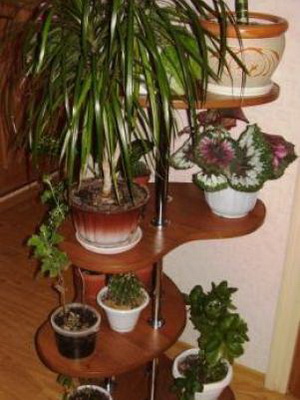
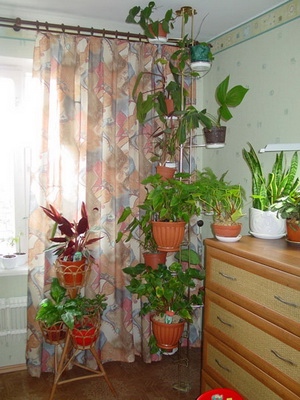

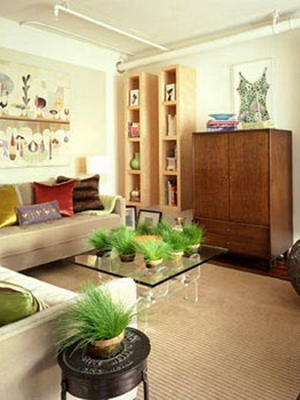
Multicolor group. Multi-color potted groups are as popular as this type of flower arrangement - a collection of vibrant flowers among a variety of foliage. Some designers, with good reason, believe that this is a too flashy way to use houseplants. This is true if a multicolor panel is mistakenly used in a room with a bright intricate pattern on carpet, wallpaper, paintings, etc. In a simple room, however, a multicolor panel can greatly enliven the setting.

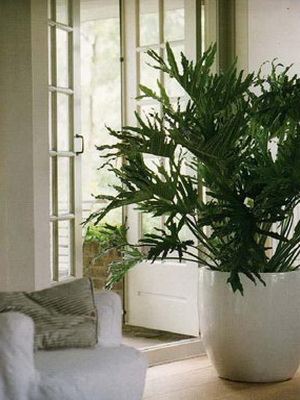
A muted group. The dominant element is plant foliage. Plants with feathery and whole leaves are used to ensure the predominance of green. To decorate the composition, you can include a few potted plants with pastel flowers, but the brightness and contrast should always be moderate. A muted composition looks good in front of patterned wallpaper or curtains; it also has a soothing effect when placed near brightly colored or ornate pieces of furniture.
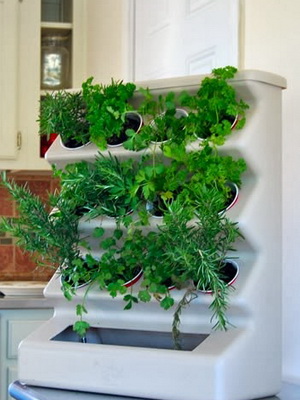
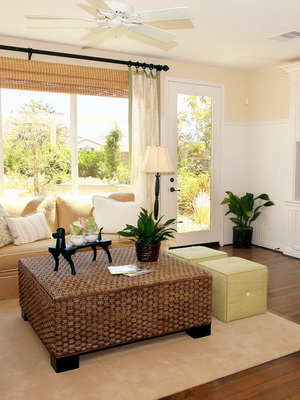
Monochrome group. Blue or white borders and cover beds from the same annual species are popular in some European countries. Despite the fact that this is common outdoors, monochromatic groups can rarely be found indoors, unless, of course, it is a set of ornamental plants. One of the most popular indoor plant compositions is a one-color indoor garden - a bowl filled with yellow daffodils or pink hyacinths.
The intricacies of caring for citrus fruits at home
Remove all ovaries the first year after planting citrus fruits. This will allow the tree to grow stronger and promote better fruiting in the next season.
As a young plant grows, you need to replenish the nutrient stores used by your citrus. This will ensure that the plant grows to its full potential. Feed citrus fruits in the spring and summer for maximum fruiting and flowering.
Citrus fruits require higher levels of potassium and magnesium
than other plants.
Lack of magnesium is a common problem in citrus fruits, as evidenced by yellowing of the leaves. Use of Epsom salt
(we pour a little on the ground).
Citrus fruits require more watering during the summer months. A well-watered citrus will have a better chance of being able to withstand insect pests and disease without any protective equipment.
Protect your plants with several layers of mulch to help keep the roots moist. And keep the area around the citrus fruit weed-free.
Whiteflies and aphids can attack your citrus fruits. Inspect plants for insect attacks.
Remove any diseased stems to improve air circulation. But remember that the leaves are the life of the tree, so don't cut unnecessarily, especially before the tree is about to bear fruit.
The use of large ornamental plants in the interior of living quarters (with photo)
Plants can be beautifully placed not only on the windowsill. A detached large decorative leaf plant or a well-composed composition of several plants pleases the eye and turns a room, hall or office into an oasis where beauty and comfort reign.

We are used to the fact that tapeworms are large, tall plants. Palm trees, yuccas, monstera, dracaena and dieffenbachias look great as a separate element of landscaping. But in the absence of such, they can be replaced, for example, by echinocactus, placed on a spectacular strong stand 70-100 cm high. Many ampelous plants and lianas can act as tapeworms. Attach large shoots to a thick palm fiber support for a great solo plant.
Using this technique for placing indoor plants, the recommended tapeworms are: araucaria, dieffenbachia, dracaena, cypress, euphorbia, monstera, nolina, palm, fatsia, ficus, philodendron, cereus, cicas, cyperus, cissus, chef flera, epipremnum, echinocactus, yucca other.

For single-growing plants, appearance is extremely important - even one leaf with spotting is able to minimize the entire decorative effect. Therefore, carefully monitor the appearance of the flower - wash its leaves more often, and adult leaves of unpretentious plants (monstera, philodendron, rubber and lyre ficus) can even be rubbed with a special plant wax.
When caring for a tapeworm plant, do not forget some rules:
- do not place large flowers in the middle of the room and in places where they will interfere with the free movement of people. Place them in free corners, making sure there is enough light;
- For larger plants, purchase ceramic pots with wide, deep trays to prevent excess water from spilling out onto the floor.
- replanting large plants is extremely difficult, so instead of replanting, you can change the top layer of the earth to fresh nutrient soil twice a year.
Look at photos of large indoor plants in the interior of living quarters:
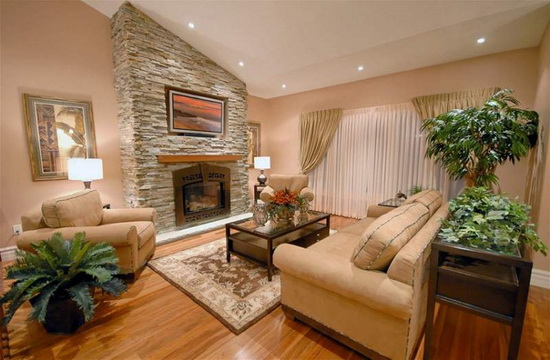
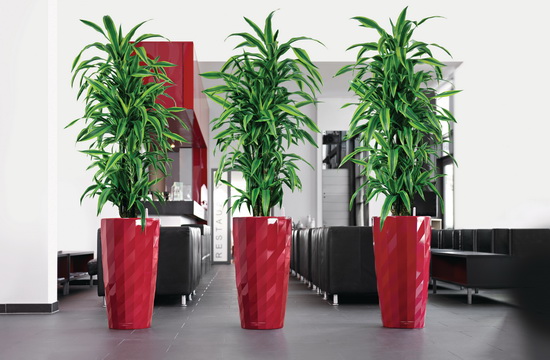
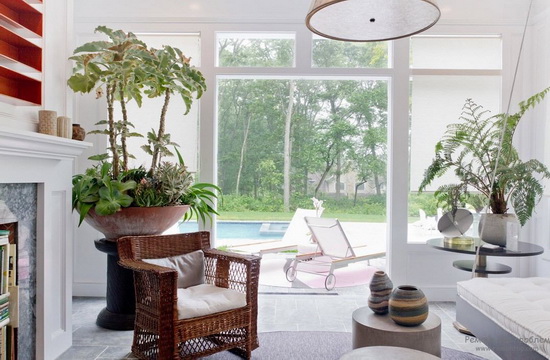

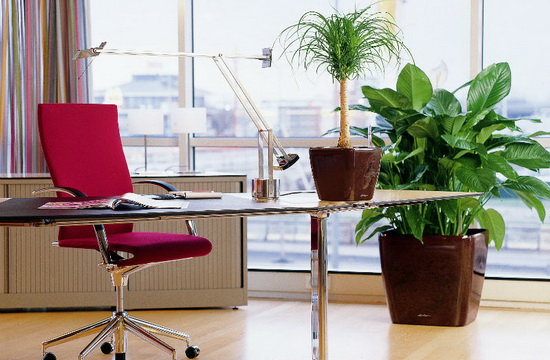
Decorative landscaping of the interior with beautiful ampelous plants
When decorating the interiors of rooms, halls, offices, as well as a terrace, balconies or loggias, ampelous plants are often used.
Ivy begonia, zerbina, tradescantia, hoya, asparagus, columnea, fuchsia, saxifrage, chlorophytum, ivy, pelargonium ivy, aporocactus, zygocactus and other plants with long flexible shoots, but they fill the interior with their greenery and not only decorate the interior with flowers ...
Beautiful ampelous plants in the interior can be placed in hanging baskets, pots, in wall vases, or can be used to build a "green wall" - a partition that divides the room into functional zones.
To do this, you need to place a narrow long flower girl on the floor, attach a decorative mesh, screen or trellis to it. They must be strong enough to support the weight of the long shoots of the plants. To do this, you can make additional fasteners on the ceiling.
The flower girl, sheathed with metal sheets or painted in silver, looks very impressive. Having securely fastened the structure, pour a layer of expanded clay, earth into the flower pot and plant several plants with flexible long shoots.
To create "green walls" use the recommended plants - they are unpretentious, grow quickly and multiply easily. In the spring, trim the shoots lightly, root the cuttings and plant in a flower girl. With such regular replanting, the wall will be evenly greened over the entire area. Recommended plants for creating "green walls": common and Canarian plush, plectranthus, roicissus, scindapsus, tradescantia, climbing philodendron, cissus, epipremnum, signonium, hoya.
With the help of climbing plants, you can not only divide the room into zones, but also create a "living carpet" on the wall. To do this, you need not trellises, but decorative hooks fixed in the wall that support flexible shoots. At the same time, the planter is placed on the floor, decorated or covered with furniture.
It is important to assess in advance the degree of illumination of the room and, if necessary, take care of additional lighting for the plants. Such a "carpet" requires minimal maintenance, and the decorative effect is very great.
When using ampelous plants, you must:
- take into account how much light, heat and moisture the plant needs;
- choose the right dishes, on which water will not flow;
- securely fix the pots;
- think over a way to water the plant at a height;
- Pour granular clay between the plant pot and the planter, which will absorb excess water when watering.
Where to put flowers in the apartment: tips
When starting gardening, keep in mind that it is necessary to place plants taking into account the peculiarities of caring for them, design rules. When choosing a place for permanent habitation, study the conditions that will be optimal for its development.

Flowering specimens often prefer well-lit areas, ferns, representatives of the Dracaena family are able to feel great in shaded conditions.

How to place flowers on a windowsill?
The window sill remains the most common plant location option. South, west or east facing windows are best suited for this. The north side is a good solution for greenery that prefers shade.

The southern side, constantly illuminated by the bright sun, is an excellent option for succulents, cacti, oleander, and roses. In the west - citrus fruits, tradescantia, coffee will be comfortably located. Eastern - will become a cozy place for azaleas, dieffenbachia, fuchsia, bulbous.

Placing flowers on the floor
Natural greenery will feel comfortable on the floor if it is tall enough and receives the required amount of light. A large, heavy pot will make the flower unsafe if placed on a table or windowsill.

The best solution to put the plant on the floor is when buying decorative dwarf trees, tall vines. By placing them symmetrically near the door, you can add symmetry to the room, making up a group - to transfer part of the garden to the house.

Placing plants on a stand
Flowers with hanging branches, curved leaves deteriorate when placed on the surface of a window sill, cabinet, shelf. Their decorativeness is revealed only when using various stands. Hanging containers, floor structures allow you to create compositions in any part of the room.
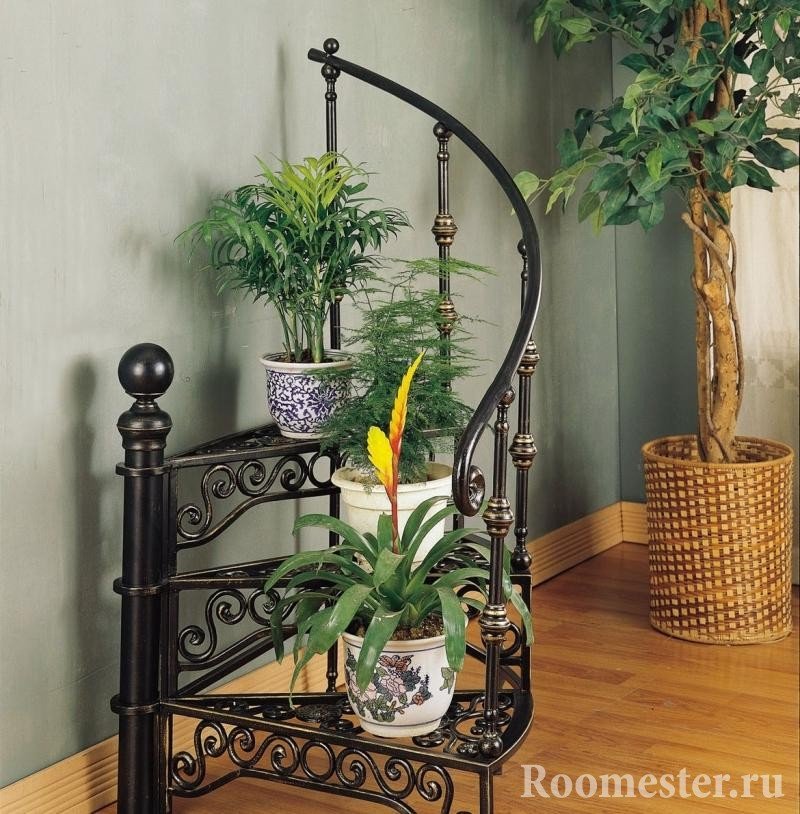
When choosing an option for placing greenery, keep in mind that they can be:
- in the form of a miniature table on a leg;
- speakers made of wood, metal, smoky glass;
- holders made of rods made of forged metal, plastic, wood;
- lattices that help divide the room into zones.
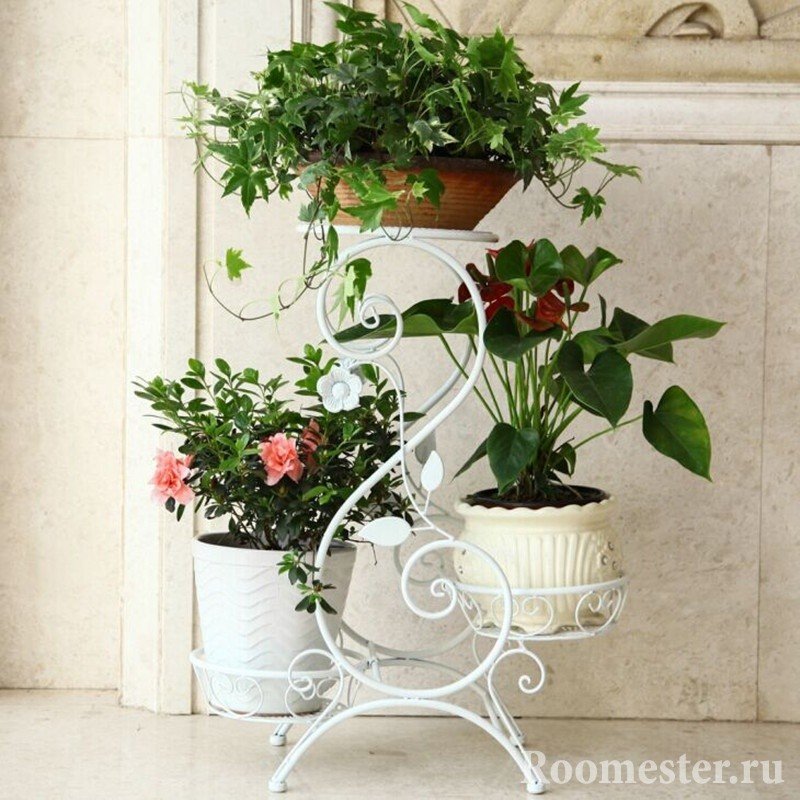
Placing flowers on walls
The wall turns into a green area when it is necessary to create a bright accent in the room, to give it individuality.To keep the air moist and not spoil the finish, select deep vessels with a capacious tray.

Flowers in the living room, the design of which you plan in advance, should be in harmony with the surface on which they will be placed:
- Luscious greenery, bright flowers will look great on delicate, pastel surfaces. Plants with variegated leaves, numerous pale flowers will be lost against a similar background, but will look great on a dark wall.
- Avoid specimens with small leaves if you have chosen a wall with a small pattern as the background. Species with large, spreading foliage will look great on it.
- Combine contrasts, shapes. The strict vertical pattern will revive the luxurious climbing plant.

Compositions of potted plants and flowers and their photos
Pot plant compositions can be formulated in various variations and combinations. A standard potted flower arrangement can be applied in any room, but artistic grouping may require experience and knowledge.
Next, you can see the compositions of potted plants in the photo, which illustrate how to arrange them:
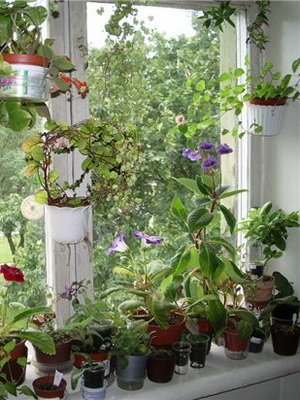
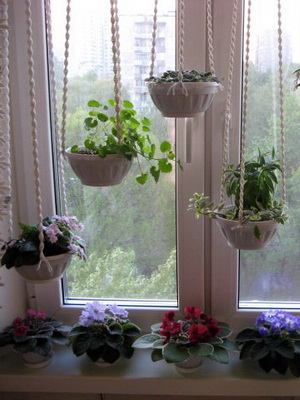


Standard grouping. A standard pot group is a collection of plants in separate pots placed close to each other. The main objects of interest are the plants, not the containers. Use generally accepted design principles to create a pot group that looks like it was made by a professional decorator. In the section on the basics of good design, you got some idea of the principles of creating compositions, and in the section on determining the place for plants, about the best position for them. And now it's time to think about choosing pots for the group - this will help the section on suitable containers. Too much variety in colors, sizes and shapes will ruin the standard pot group.
It's time to get some plants. Pick three or another odd number of plants. All plants in the group should have similar temperature and light requirements. There should also be a range of different heights and textures. Ornamental-leaved plants are usually chosen for a permanent base and several flowering plants to give the composition color.
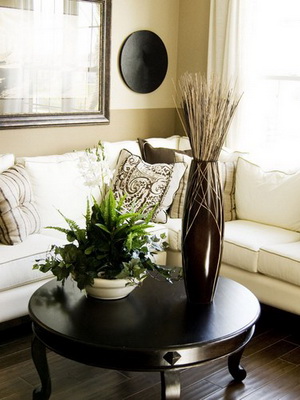
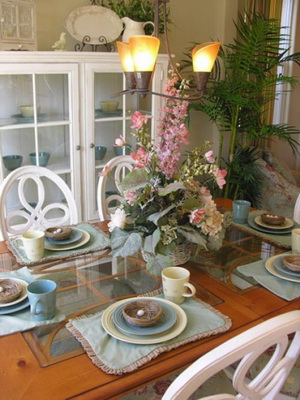
Composing a composition. If the potted group is only visible from the front and sides, then, in accordance with the general rule, tall plants should be in the back, and smaller ones in the foreground. Straight lines should be avoided - for example, lower the height of the rear at the sides and provide vertical drops to create a sense of movement. The overall shape of the composition is a matter of personal taste; the wrong pyramid is popular. If the composition is supposed to be viewed from all sides, taller plants are placed in the middle, surrounded by smaller plants. Once again, it is necessary to break this general form in order to provide dynamics.
A little warning. A riot of colors, shapes and textures is unlikely to give your potty group a professional look. Compositions created by interior designers are often quite restrained and can consist of only ornamental plants.
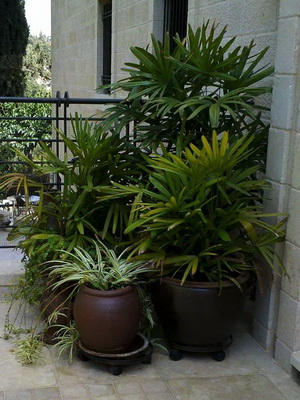
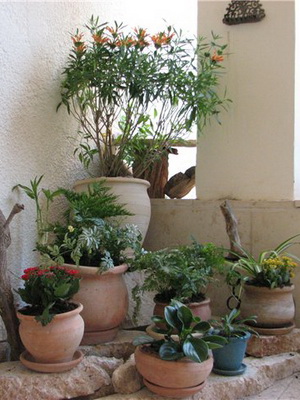
Artistic grouping. Designers sometimes create large and exotic potted groups filled with gorgeous plants in unusual containers. But the size, type and color of plants are not the main features of the art potting group. There are only two basic requirements.
Firstly, pots of at least two different heights are used - this creates a sense of volume. Secondly, the selection of pots is no less important than the selection of plants - in the composition, both of these components should be decorative.
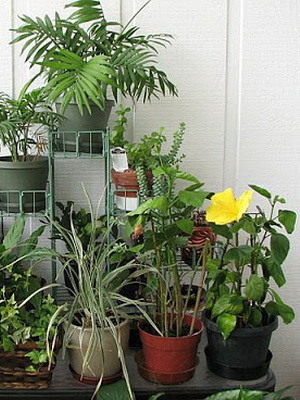

Planters are one of the main elements. In the composition shown above, the back planter contains a palm tree that is much taller than the rest of the plants.Smaller plants can be set up by lifting them up with a block of wood under the pot
It is very important that this top plant provides maximum decorative effect. The smallest pot contains a flowering pot plant that is replaced when the flowers wither
An ampel plant is grown in one of the medium vessels, and its stems fall freely at the base of the composition.
Vertical pot group
If the space in the apartment is limited, but the desire of the grower to have a beautiful garden at home is enormous, then vertical potting groups help in this.
Vertical compositions are placed on different surfaces:
- wooden or metal stands;
- metal picket fence on the wall;
- hanging pots or baskets;
- shelving (for example, corner);
- walls with a special recess for pots.
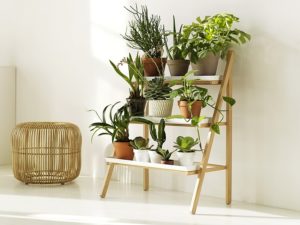 For vertical compositions, various indoor plants are used, but most often ampelous. The name "ampelous" plants (from German. Ampel) received for their hanging and creeping shape. Bellflower, nidularium, ivy, creeping ficus, fittonia, hoya and other ampelous flowers can be seen in potted groups.
For vertical compositions, various indoor plants are used, but most often ampelous. The name "ampelous" plants (from German. Ampel) received for their hanging and creeping shape. Bellflower, nidularium, ivy, creeping ficus, fittonia, hoya and other ampelous flowers can be seen in potted groups.
The vertical arrangement not only visually increases the volume of the room, but also improves the microclimate in the house, therefore, designers also use these compositions in large houses when decorating the interior.
The most important thing for both flower growers and professional craftsmen is to follow certain rules for creating compositions.
Basic techniques for placing flowers
It is important not only to purchase flowers and choose suitable pots, but also to arrange them correctly in the house, creating flower arrangements
In the bedroom
This is a place to sleep and rest, so the atmosphere here should be relaxing and conducive to healthy sleep. Therefore, poisonous plants with a strong smell are not suitable for the bedroom. It is better to place those options that purify the air and even emit a minimum of carbon dioxide at night. Such useful plants include spathiphyllum, chlorophytum, ficus, aloe. They will give positive emotions and contribute to relaxation of pelargonium, begonia, violet.
In the nursery
The nursery is not the ideal place to place plants. Games are constantly taking place here, and sometimes problems with broken pots and scattered earth cannot be avoided. Therefore, it is best not to place plants on the floor, but to choose hanging planters or shelves. Aloe or Kalanchoe can be placed on the windowsill. It would be appropriate to be located on a shelf or bedside table of the florarium. In addition to plants and decorative elements, you can include small toys in the compositions and create whole plots.
On the kitchen
As for the kitchen, there is usually high humidity and temperature changes. Therefore, flowers should be placed those that are able to withstand such conditions. In fact, you can place any flowers, the main thing is to take into account their location. Sanseieria, philodendron, common ivy, aspidistra, aloe, Kalanchoe, geranium, begonia will feel good in the kitchen. You just need to remember that you should not place plants near the sink. Not only is it constantly wet and splashes are flying, it is also possible that drops of cleaning and detergents will get on the foliage. Flowers cannot be placed near the stove either. It's too hot there, and odors won't do the plants any good.
In the hall
The hallway is usually dark. Therefore, not every plant is able to survive here. It is desirable to create artificial lighting. The shadow of aglaonema, aspidistra, asplenium, sansevieria is well tolerated. Ferns feel great in a shaded place. But if the hallway is completely dark, artificial options can also be considered as an alternative to living flowers.
In the living room
The hall is the place where a wide variety of plants are most often placed. Here you can place different representatives of the flora - separately or combining them into compositions.If the living room is spacious, then a green wall will also be appropriate here, the main thing is to very carefully approach its arrangement. Both phyto-paintings and florariums will look good.
Placing flowers in the interior on the walls
For walls, either flowering plants are most often chosen to create a spot of color on the pastel surface of the wall, or vines to frame a picture, window, etc.
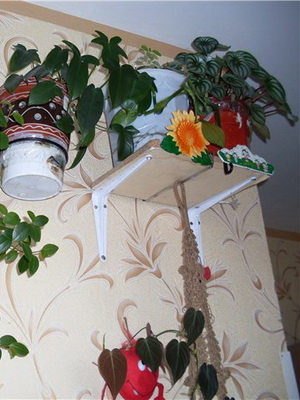

Placing flowers in the interior on the walls can have one peculiarity - some difficulties arise: it is not easy to keep the surrounding air humid, and frequent watering will be required. Choose vessels with a large and deep base.
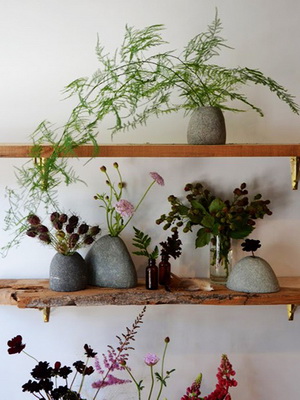
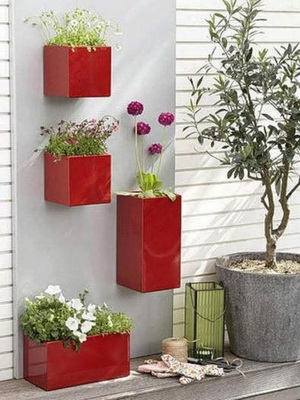
For most plants, a pale pastel background with no pattern is best. This is especially true for completely green ornamental plants and bright flowers.
Plants with very variegated leaves and plants with masses of light flowers may appear pale when set against a light background. A darker surface creates a better visual effect.
Small leaves are often lost in complex backgrounds. Place these plants against a plain wall and use large-leaved species in front of the patterned surface.
Use contrasts of color and shape for a dramatic effect. A background with strictly vertical stripes can be brought to life by placing a sprawling plant in front of it.
Plants in the interior of the bathroom

The bathroom is a place of solitude, where we usually spend time with our loved ones. And of course, beautiful green plants come in handy to create a pleasant relaxing atmosphere! However, it is rare to find this kind of decor in small bathrooms. The small space does not allow for large plants in the bathroom.

Indoor plants in the bathroom
With the right approach, plants can transform any interior. The main thing is to take care of them and love them, then your little home garden will delight you more and more.
To the surprise of many, you can also organize your own mini-garden in the bathroom. The bathroom has an individual microclimate that differs sharply from the rest of the premises. Increased humidity, temperature fluctuations should definitely be taken into account when placing plants in the interior of the bathroom - after all, not every green space is able to withstand such conditions.
The choice should also be based on the size of the room. For example, a small bathtub will be beautifully complemented by curly ivy, philodendron. The larger rooms will be complemented by shrub aspidistra, and the plants in the interior of the spacious bathroom are dieffenbachia, ficus, alocasia. All of them will contribute to creating a pleasant, relaxing atmosphere.
In conclusion, I would like to say about a somewhat new style for our latitudes - Japanese, which, nevertheless, managed to spread its roots in the design of the premises. When choosing plants for the Japanese interior, choose a few small crops - let it be a bonsai tree or one or two orchids. In the east, it is customary to admire the beauty of one flower, rather than lush thickets.
Love your indoor plants, take care of them - then they will undoubtedly endow you with all their beauty and vitality.
Types of home gardening
There are two main types of landscaping:
- Vertical;
- Horizontal.
In the first case, indoor plants are mounted in stands and holders located in a vertical plane. At the same time, the horizontal plane remains free and unloaded.
When placed horizontally, the plants are planted along the horizon, that is, on the floor, shelves, window sills, coffee tables, chests of drawers.
Horizontal placement has several significant disadvantages:
- Visually reduces the area of the room;
- With a lot of greenery and large outdoor flowers, the interior looks overwhelmed.
Interior decoration
If there is a lot of flora in the interior of the apartment, then you need to consider whether living plants can safely be with each other. Plants should be placed in the neighborhood, taking into account the similarity of their requirements for illumination and watering. In addition, when creating a beautiful design, it is advisable to place flowers nearby with different shapes, textures and color of the leaves.
You can arrange a classic composition in one flowerpot: along the edges, miniature plants, forming a lush border, then flora with bright large leaves, and a tall flower in the center.
Large outdoor types can be selected for minimalistic stylizations: pike tail, dracaena. The modern interior is accentuated by flowerpots made of steel. Blooming flora is actively used in the Scandinavian style. For such a decor, pots in bright contrasting colors would be ideal.
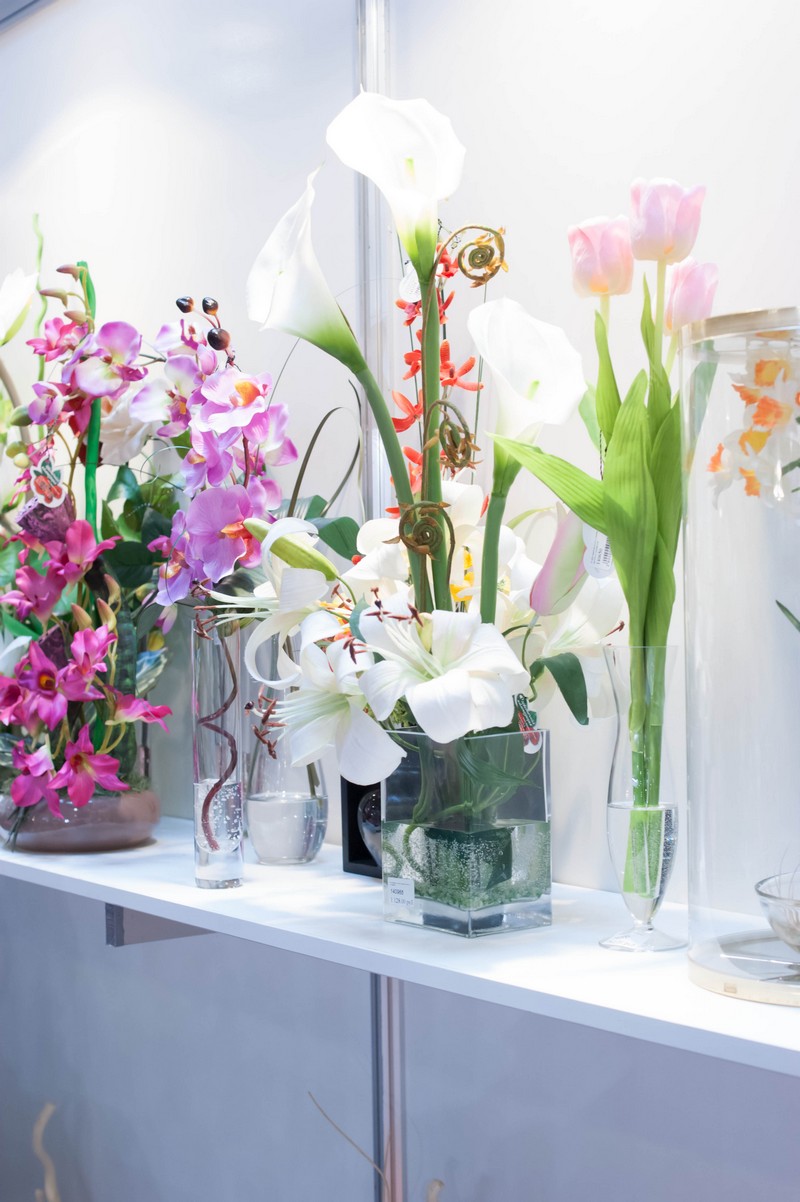
Room decoration with fresh flowers

Florariums are glass vessels in which thermophilic tropical flora grows. At the peak of popularity in phytodesign today is rutary. Various stumps, roots and branches of trees are the basis for installing flowerpots with flowering varieties in niches made in them. This decor has a quirky shape and looks stylish and natural.
Another interesting idea is that a tall single flower is planted in a floor vase in which moss or curly varieties are planted.

Fresh flowers in the interior of the room

Room decor with flowers
To create a beautiful interior with flowers, you need to think carefully about the design. You can also consider how other growers arrange the space.
Such a two-tiered composition of different plants may well fit against one of the walls in a spacious room. Pots of the same color give the composition a certain completeness.
Plants interior decoration
The green flora ennobles the design of the room, brings notes of naturalness to it. Plants are placed in the interior of the apartment taking into account several factors - the background of the walls, the illumination of the site, the dimensions of the room. To create the composition, floor vases, wall pots, stands for a group of pots, shelves, and ceiling pendants are used. Installation on a windowsill is the most common method. Plants differ in leaf size, growth mode (hanging or tall), and flowering options. The choice of varieties to create a beautiful oasis depends on this.
Climbing plants in the interior
Green hanging twigs can create a luxurious natural carpet in the room. With their help, you can decorate a corner, decorate an empty wall, use it for zoning a room. Even single plants in the interior look impressive due to their splendor. The most popular climbing varieties include indoor grapes, ivy, scindapsus, creeping ficus, episcia, bell, jasmine.
Climbing plants in the interior can beautifully braid stands, supports, have an interesting shape and shades of leaves, some delight with bright flowers. Most of these varieties are unpretentious, hardy, not demanding on the lighting and watering regime. With their help, it is easy to create bright compositions and beautiful patterns on the walls, in hanging planters or pots using stands.
Large plants in the interior
Turning a room into a colorful greenhouse is easy with large indoor flowers. Large ornamental plants for the interior - ficus with fleshy leaves, various palms, boxwood, yucca, dracaena. Popular are orange, lemon trees, wild rose, dieffenbachia. Lovers of flower growers can give the indoor boxwood an original shape through a special haircut.
Ficus benjamin looks interesting, the trunks of which can be braided into a braid or spiral, a banana that blooms for many months. Fashionable novelties - coffee tree or olive, kumquat with bright orange fruits.They are located in floor pots near the windows, in the corners of the room, near the sofa or coffee table. You can create original oases by composing an ensemble of several pots of different sizes
Compositions of indoor plants in the interior
Each flower needs a beautiful presentation, it needs to be presented in a favorable light, to find a place in the house where it looks beautiful and grows best. To create stylish compositions, modern phytodesign is used, plants in the interior are combined in one or several pots to equip an oasis with special expressiveness.
You can decorate the room with a tall single flower, the bottom of the trunk in a floor vase is planted with moss or curly green varieties. Several potted flowers can be placed on a windowsill or floor. Within the group, there must be a large specimen with a dense crown, medium varieties must be arranged around it in a tiered order. Among the short plants, flowering variants should be present. No more than five pots are used to create a stylish oasis.
Orchid lovers can create a bright composition using exotic beauties gathered in an inflorescence and a low-growing coral pentasa with a simple flowering or ordinary green ivy, from the thickets of which oriental buds will grow beautifully on tall stems. Even a few violets planted in flat pots, complemented by a small sculpture, make up an unexpected display.
Modern novelties of florists - florariums. They are transparent vessels in which thermophilic tropical plants grow, they do not need to be devoted much time. The trendy trend in phytodesign is rutaria. Various roots, stumps, branches of trees are used as a basis for installing pots with flowering varieties in niches hollowed out in them. The composition has a bizarre shape and looks natural.


